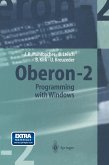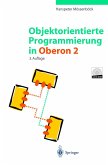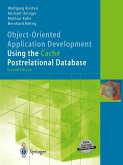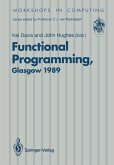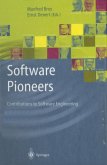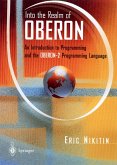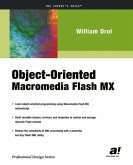40,95 €
40,95 €
inkl. MwSt.
Sofort per Download lieferbar

20 °P sammeln
40,95 €
Als Download kaufen

40,95 €
inkl. MwSt.
Sofort per Download lieferbar

20 °P sammeln
Jetzt verschenken
Alle Infos zum eBook verschenken
40,95 €
inkl. MwSt.
Sofort per Download lieferbar
Alle Infos zum eBook verschenken

20 °P sammeln
- Format: PDF
- Merkliste
- Auf die Merkliste
- Bewerten Bewerten
- Teilen
- Produkt teilen
- Produkterinnerung
- Produkterinnerung

Bitte loggen Sie sich zunächst in Ihr Kundenkonto ein oder registrieren Sie sich bei
bücher.de, um das eBook-Abo tolino select nutzen zu können.
Hier können Sie sich einloggen
Hier können Sie sich einloggen
Sie sind bereits eingeloggt. Klicken Sie auf 2. tolino select Abo, um fortzufahren.

Bitte loggen Sie sich zunächst in Ihr Kundenkonto ein oder registrieren Sie sich bei bücher.de, um das eBook-Abo tolino select nutzen zu können.
The book describes a practical approach to object-oriented programming and design. After explaining the basic concepts of object orientation it shows with numerous realistic examples how this technique can be used to write extensible and well-structured software. It addresses programmers and practitioners.
- Geräte: PC
- ohne Kopierschutz
- eBook Hilfe
- Größe: 32.92MB
Andere Kunden interessierten sich auch für
![Oberon-2 Programming with Windows (eBook, PDF) Oberon-2 Programming with Windows (eBook, PDF)]() Jörg R. MühlbacherOberon-2 Programming with Windows (eBook, PDF)72,95 €
Jörg R. MühlbacherOberon-2 Programming with Windows (eBook, PDF)72,95 €![Objektorientierte Programmierung in Oberon-2 (eBook, PDF) Objektorientierte Programmierung in Oberon-2 (eBook, PDF)]() Hanspeter MössenböckObjektorientierte Programmierung in Oberon-2 (eBook, PDF)51,24 €
Hanspeter MössenböckObjektorientierte Programmierung in Oberon-2 (eBook, PDF)51,24 €![Object-Oriented Application Development Using the Caché Postrelational Database (eBook, PDF) Object-Oriented Application Development Using the Caché Postrelational Database (eBook, PDF)]() Wolfgang KirstenObject-Oriented Application Development Using the Caché Postrelational Database (eBook, PDF)40,95 €
Wolfgang KirstenObject-Oriented Application Development Using the Caché Postrelational Database (eBook, PDF)40,95 €![Functional Programming (eBook, PDF) Functional Programming (eBook, PDF)]() Functional Programming (eBook, PDF)40,95 €
Functional Programming (eBook, PDF)40,95 €![Software Pioneers (eBook, PDF) Software Pioneers (eBook, PDF)]() Software Pioneers (eBook, PDF)112,95 €
Software Pioneers (eBook, PDF)112,95 €![Into the Realm of Oberon (eBook, PDF) Into the Realm of Oberon (eBook, PDF)]() Eric W. NikitinInto the Realm of Oberon (eBook, PDF)40,95 €
Eric W. NikitinInto the Realm of Oberon (eBook, PDF)40,95 €![Object-Oriented Macromedia Flash MX (eBook, PDF) Object-Oriented Macromedia Flash MX (eBook, PDF)]() William DrolObject-Oriented Macromedia Flash MX (eBook, PDF)28,95 €
William DrolObject-Oriented Macromedia Flash MX (eBook, PDF)28,95 €-
-
-
The book describes a practical approach to object-oriented programming and design. After explaining the basic concepts of object orientation it shows with numerous realistic examples how this technique can be used to write extensible and well-structured software. It addresses programmers and practitioners.
Dieser Download kann aus rechtlichen Gründen nur mit Rechnungsadresse in A, B, BG, CY, CZ, D, DK, EW, E, FIN, F, GR, HR, H, IRL, I, LT, L, LR, M, NL, PL, P, R, S, SLO, SK ausgeliefert werden.
Produktdetails
- Produktdetails
- Verlag: Springer Berlin Heidelberg
- Seitenzahl: 278
- Erscheinungstermin: 6. Dezember 2012
- Englisch
- ISBN-13: 9783642798986
- Artikelnr.: 53391788
- Verlag: Springer Berlin Heidelberg
- Seitenzahl: 278
- Erscheinungstermin: 6. Dezember 2012
- Englisch
- ISBN-13: 9783642798986
- Artikelnr.: 53391788
- Herstellerkennzeichnung Die Herstellerinformationen sind derzeit nicht verfügbar.
The book describes a practical approach to object-oriented programming and design. After explaining the basic concepts of object orientation it shows with numerous realistic examples how this technique can be used to write extensible and well-structured software. It addresses programmers and practitioners.
1 Overview.- 1.1 Procedure-Oriented Thinking.- 1.2 Object-Oriented Thinking.- 1.3 Object-Oriented Languages.- 1.4 How OOP Differs from Conventional Programming.- 1.5 Classes as Abstraction Mechanisms.- 1.6 History of Object-Oriented Languages.- 1.7 Summary.- 2 Oberon-2.- 2.1 Features of Oberon-2.- 2.2 Declarations.- 2.3 Expressions.- 2.4 Statements.- 2.5 Procedures.- 2.6 Modules.- 2.7 Commands.- 3 Data Abstraction.- 3.1 Concrete Data Structures.- 3.2 Abstract Data Structures.- 3.3 Abstract Data Types.- 4 Classes.- 4.1 Methods.- 4.2 Classes and Modules.- 4.3 Examples.- 4.4 Common Questions.- 5 Inheritance.- 5.1 Type Extension.- 5.2 Compatibility of a Base Type and its Extension.- 5.3 Static and Dynamic Type.- 5.4 Run-Time Type Checking.- 5.5 Extensibility in an Object-Oriented Sense.- 5.6 Common Questions.- 6 Dynamic Binding.- 6.1 Messages.- 6.2 Abstract Classes.- 6.3 Examples.- 6.4 Message Records.- 6.5 Common Questions.- 7 Typical Applications.- 7.1 Abstract Data Types.- 7.2 Generic Components.- 7.3 Heterogeneous Data Structures.- 7.4 Replaceable Behavior.- 7.5 Adaptable Components.- 7.6 Semifinished Products.- 7.7 Summary.- 8 Useful Techniques.- 8.1 Initialization of Objects.- 8.2 Extending a System at Run Time.- 8.3 Persistent Objects.- 8.4 Wrapping Classes in Other Classes.- 8.5 Extensibility in Multiple Dimensions.- 8.6 Multiple Inheritance.- 8.7 Models and Views.- 8.8 Iterators.- 8.9 Modifying Inherited Methods.- 9 Object-Oriented Design.- 9.1 Functional Design.- 9.2 Object-Oriented Design.- 9.3 Identifying the Classes.- 9.4 Designing the Interface of a Class.- 9.5 Abstract Classes.- 9.6 Relationships between Classes.- 9.7 When to Use Classes.- 9.8 Common Design Errors.- 10 Frameworks.- 10.1 Subsystems and Frameworks.- 10.2 The MVC Framework.- 10.3 A Framework forObjects in Texts.- 10.4 Application Frameworks.- 11 Oberon0 - A Case Study.- 11.1 The Viewer System.- 11.2 Handling User Input.- 11.3 A Text Editor.- 11.4 A Graphics Editor.- 11.5 Embedding Graphics in Texts.- 12 Costs and Benefits of OOP.- 12.1 Benefits.- 12.2 Costs.- 12.3 The Future.- A Oberon-2 - Language Definition.- A.1 Introduction.- A.2 Syntax.- A.3 Vocabulary and Representation.- A.4 Declarations and Scope Rules.- A.5 Constant Declarations.- A.6 Type Declarations.- A.7 Variable Declarations.- A.8 Expressions.- A.9 Statements.- A.10 Procedure Declarations.- A.11 Modules.- A.12 Appendices to the Language Definition.- B The Module OS.- C The Module IO.- D How to Get Oberon.
1 Overview.- 1.1 Procedure-Oriented Thinking.- 1.2 Object-Oriented Thinking.- 1.3 Object-Oriented Languages.- 1.4 How OOP Differs from Conventional Programming.- 1.5 Classes as Abstraction Mechanisms.- 1.6 History of Object-Oriented Languages.- 1.7 Summary.- 2 Oberon-2.- 2.1 Features of Oberon-2.- 2.2 Declarations.- 2.3 Expressions.- 2.4 Statements.- 2.5 Procedures.- 2.6 Modules.- 2.7 Commands.- 3 Data Abstraction.- 3.1 Concrete Data Structures.- 3.2 Abstract Data Structures.- 3.3 Abstract Data Types.- 4 Classes.- 4.1 Methods.- 4.2 Classes and Modules.- 4.3 Examples.- 4.4 Common Questions.- 5 Inheritance.- 5.1 Type Extension.- 5.2 Compatibility of a Base Type and its Extension.- 5.3 Static and Dynamic Type.- 5.4 Run-Time Type Checking.- 5.5 Extensibility in an Object-Oriented Sense.- 5.6 Common Questions.- 6 Dynamic Binding.- 6.1 Messages.- 6.2 Abstract Classes.- 6.3 Examples.- 6.4 Message Records.- 6.5 Common Questions.- 7 Typical Applications.- 7.1 Abstract Data Types.- 7.2 Generic Components.- 7.3 Heterogeneous Data Structures.- 7.4 Replaceable Behavior.- 7.5 Adaptable Components.- 7.6 Semifinished Products.- 7.7 Summary.- 8 Useful Techniques.- 8.1 Initialization of Objects.- 8.2 Extending a System at Run Time.- 8.3 Persistent Objects.- 8.4 Wrapping Classes in Other Classes.- 8.5 Extensibility in Multiple Dimensions.- 8.6 Multiple Inheritance.- 8.7 Models and Views.- 8.8 Iterators.- 8.9 Modifying Inherited Methods.- 9 Object-Oriented Design.- 9.1 Functional Design.- 9.2 Object-Oriented Design.- 9.3 Identifying the Classes.- 9.4 Designing the Interface of a Class.- 9.5 Abstract Classes.- 9.6 Relationships between Classes.- 9.7 When to Use Classes.- 9.8 Common Design Errors.- 10 Frameworks.- 10.1 Subsystems and Frameworks.- 10.2 The MVC Framework.- 10.3 A Framework forObjects in Texts.- 10.4 Application Frameworks.- 11 Oberon0 - A Case Study.- 11.1 The Viewer System.- 11.2 Handling User Input.- 11.3 A Text Editor.- 11.4 A Graphics Editor.- 11.5 Embedding Graphics in Texts.- 12 Costs and Benefits of OOP.- 12.1 Benefits.- 12.2 Costs.- 12.3 The Future.- A Oberon-2 - Language Definition.- A.1 Introduction.- A.2 Syntax.- A.3 Vocabulary and Representation.- A.4 Declarations and Scope Rules.- A.5 Constant Declarations.- A.6 Type Declarations.- A.7 Variable Declarations.- A.8 Expressions.- A.9 Statements.- A.10 Procedure Declarations.- A.11 Modules.- A.12 Appendices to the Language Definition.- B The Module OS.- C The Module IO.- D How to Get Oberon.

